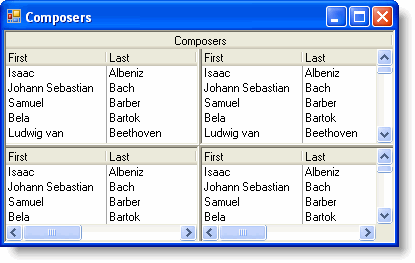List for WinForms supports a rich object model that reflects the organization of its visual components. Therefore, in order to customize a list's appearance and behavior, you need to know how the Properties window and collection editors reflect the list's object model.
Split-Specific Properties
A split is similar to the split window features of products such as Microsoft Excel and Word. You can use splits to present your data in multiple vertical or horizontal panes. These panes, or splits, can display data in different colors and fonts. They can scroll as a unit or individually, and they can display different sets of columns or the same set. You can also use splits to prevent one or more columns or rows from scrolling. The image below, for example, includes a list with both a horizontal and a vertical split, creating four panes.

By default, a list contains a single split comprising all of its columns. Note that most of the split properties are not present in the main Properties window. For example, you cannot set the AlternatingRows property without opening up the Splits Collection Editor and modifying the Split object, because the value of this property can vary from split to split. The term split-specific is used to describe such properties, since they apply to individual splits rather than the list as a whole. For more information about accessing split-specific properties, see Accessing Split-Specific Properties.
Global Properties
Conversely, the term global is used to describe properties that apply to the list as a whole, such as DataView and BorderStyle. Global properties are accessible through the Properties window, which is initially located in the lower right of the .NET IDE. The latter also shows extender properties specific to the Visual Studio environment, such as Align and Tag. For more information about accessing global properties, see Accessing Global List Properties.
Split-Specific Properties vs. Global Properties
The distinction between split-specific and global properties also extends to the two column objects which represent the columns of data within the list. Both of these objects govern a column's properties. The C1DataColumn object contains all of the column properties related to data access and formatting. The C1DisplayColumn object contains all of the column properties related to the column's visual display. The C1DataColumn properties are global column properties. These are properties that apply to all of the columns in the list, no matter their placement among the splits. For instance, when you add or remove a column, you would add or remove the associated C1DataColumn. On the other hand the C1DisplayColumn properties are split-specific properties. Setting one of these properties in one split doesn't mean that the properties are then set in all splits.